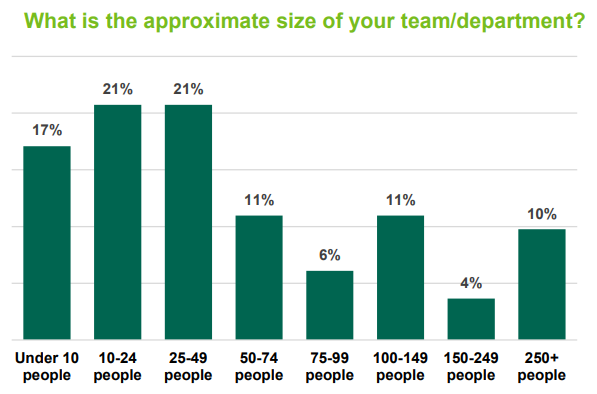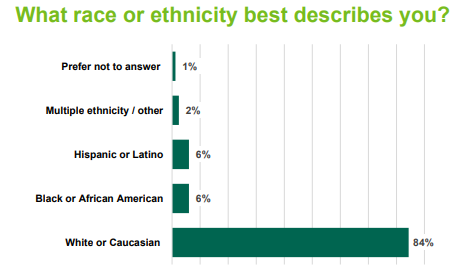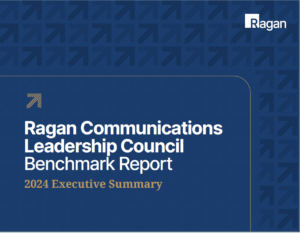CCOs help comms resonate from the inside out. Here’s how.
Korn Ferry’s Chief Communications Officer survey invited the most senior-level comms executives at Fortune 500 companies to weigh in on their influence.

In a world rife with social and political unrest, economic and health-related uncertainties, the communications function has assumed a rightful place in the spotlight. As such, the role and responsibilities of the Chief Communications Officer (CCO) have also come into focus.
With this in mind, global consulting firm Korn Ferry recently published its Chief Communications Officer survey, inviting the most senior-level comms executives at Fortune 500 companies to weigh in on their growing influence, org structure and more. Among the many insights in this report are the 55% of respondents who said they look for internal comms acumen when hiring candidates. This was the second-most desired trait, trailing only behind media relations skills.
Peter McDermott, senior client partner in Korn Ferry’s global corporate affairs and investor relations practice, says that, while internal comms engagement has always been important within comms, we’re in a moment when the external world sees the importance of internal and employee engagement for the first time.
This has largely been sparked by the pandemic changing the way we work and a mixternal approach to managing corporate comms around social issues of the day, or one that includes both internal and external strategies around the same effort. What may have once been a campaign about optics is now about the substance of measurement, action and accountability. Employees are now understood to be your most important customers.
“Through COVID, organizations have been able to measure the economic impact of talent retention and how that relates to employee engagement, what employees actually care about, what they’re passionate about in terms of the values and mission of the organizations they’re working for,” explains McDermott, adding that this sort of work has helped dissolve the barrier between internal and external comms.
“A lot of folks are writing their internal messaging as they would message it to external stakeholders, the press and community leaders.”
“Internal comms really moved from being an outlier to being the center of the organization because you’re at the center of the table,” adds Richard Marshall, global managing director of corporate affairs & investor relations at Korn Ferry. “Whether it’s returning to work, returning to the office, social justice issues or Supreme Court rulings, the messaging and strategy from leadership emanates from the inside out. And the inside voices are also the outside voices. So there’s a greater recognition that your internal audiences are the most important audiences.”
This is why getting the alignment, strategy and inputs right are critically more important than ever in this highly chaotic, disruptive time.
Team growth reflects an increased focus on corporate reputation and internal comms.
Among those who took Korn Ferry’s survey, a quarter (25%) of respondents said that they have teams of 100+, up from the 16% reported in the agency’s last survey in 2014-2015, while 10% of that group have teams of 250+. The leading areas of focus for CCOs are corporate comms, media relations, issues & crisis management and social & digital media. Notable areas of greater focus include corporate reputation (95% in 2023 versus 89% in 2014-2015) and internal communications (96% in 2023 versus 91% in 2014-2015).

Courtesy of Korn Ferry
Marshall says that these increases demonstrate how the CCO’s mandate has broadened to increasingly focus on reputation, values and culture, as there’s been a sea change of content shifting internally through internal content engines that require more staffing. “It used to be that you’d rely on third-party sources on the media relations side of things,” he explains, “but more companies are internally sourcing and doing their own digital content, so they’re hiring more staff for content creation.”
McDermott adds that a lot of responsibilities that used to sit formally in advertising and marketing are moving over to comms, a shift that started before COVID but has become more strategic since. This has prompted data analytics and measurement to move to the forefront of comms along with the content engine, with these folks reporting directly to the CCO.
This has also fallen under the CCO’s purview because of what Marshall calls “organizational jump balls” as organizations try to figure out who internally owns reputation, who owns culture and who owns ESG or social impact.
“These are the things the CCO is uniquely qualified to step in and fill the void (for) because they’re the ones who are interfacing with the whole flywheel of stakeholders,” he explains. “They’ve got a lens around every one of these stakeholders and so as a result, they’re adding greater value in the C-suite by being able to offer counsel advice, game scenario planning, issues management planning, all these sorts of things to look at (through) all the different lenses of different stakeholders.”
Fixing the lack of diversity among CCOs
It’s worth noting that 84% of CCO respondents in this survey identified as white. This prompts the question of what the C-suite has when it comes to embedding DE&I throughout the organization.

Courtesy of Korn Ferry
“We are noticing a pattern of organizations trying to solve this at the top rather than thinking through succession planning, partnerships with HBCUs and hiring from entry-level to think about creating a pipeline of diverse talent,” McDermott says, emphasizing the importance of having the right people at the table when you make decisions for your employees, stakeholders and brand. Putting somebody at the top who is not given the autonomy or perspective to see operational deficits and where something falls apart is a failure of learning and upskilling pathways, something Korn Ferry offers counsel on as outside advisors to help clients see the forest from the trees.
McDermott also sits on the board for the LAGRANT Foundation, which provides scholarship opportunities, internships and more.
“We’re seeing more companies step up, and that’s ultimately the long-term solution,” adds Marshall, “giving opportunities to people coming out of school from different backgrounds, getting the career trajectory that they need so they’ve got the skills to operate at the very top level. There’s been a big move over the last few years to push that.
Having a non-wobbly seat at the center of the table
How does comms have a stable seat at the C-suite table, ideally one that’s in the middle so CCOs are central to decision-making? There’s no other executive that must look at such a vast array of different stakeholders and sort out the messaging, the strategy and how it will impact reputation. Marshall believes CEOs understand this more.
“The greatest value the CCO can bring is to be the advisor at the center of the table, providing that 360-degree perspective of all different stakeholders that the enterprise interfaces with,” he says. “It’s vetted out in this survey—they’re being drawn on. (Comms) is no longer a production shop, no longer at the end of the processing line.”
“When asking about a seat at the table, a lot of times people look at that as a direct relationship to the CEO and the board,” McDermott adds, “and I don’t think that the CCO necessarily needs that on paper to have the influence and be at the middle of everything. If you’re building the right kind of relationships of influence in the organization, you earn that seat at the table, even if it’s not through a direct reporting relationship.”
Justin Joffe is the Editor-in-chief at Ragan Communications. Before joining Ragan, Joffe worked as a freelance journalist and communications writer specializing in the arts and culture, media and technology PR, and ad tech beats. His writing has appeared in several publications including Vulture, Newsweek, Vice, Relix, Flaunt, and many more. You can find him on Twitter @joffaloff.







